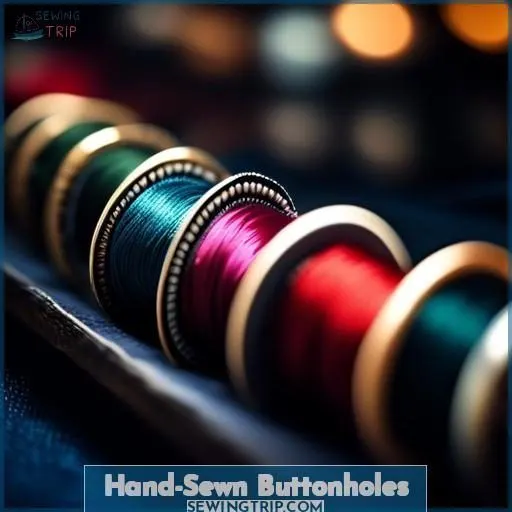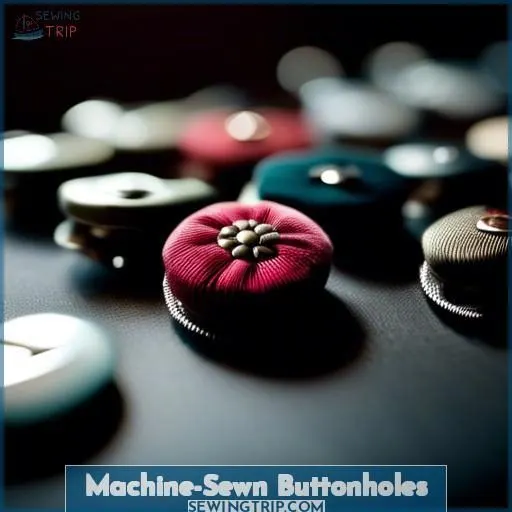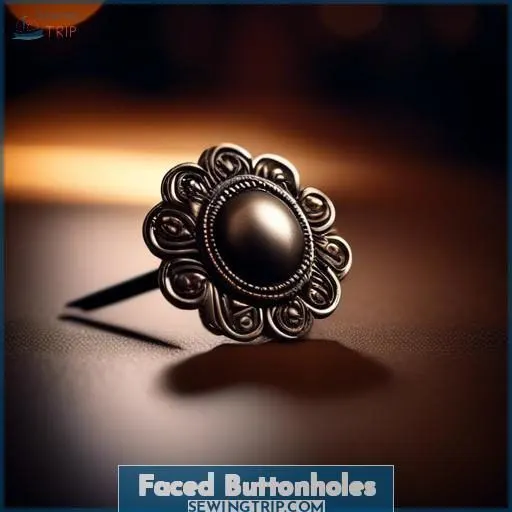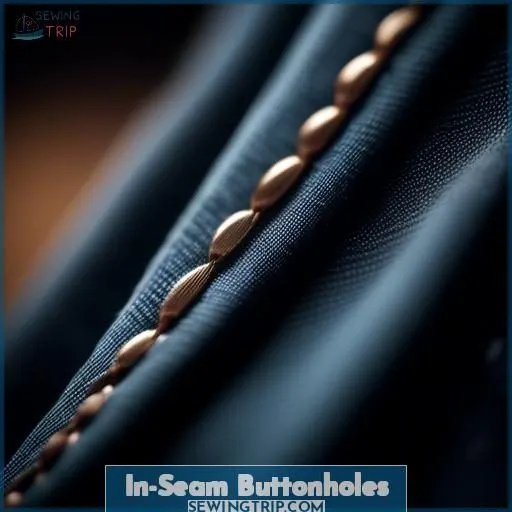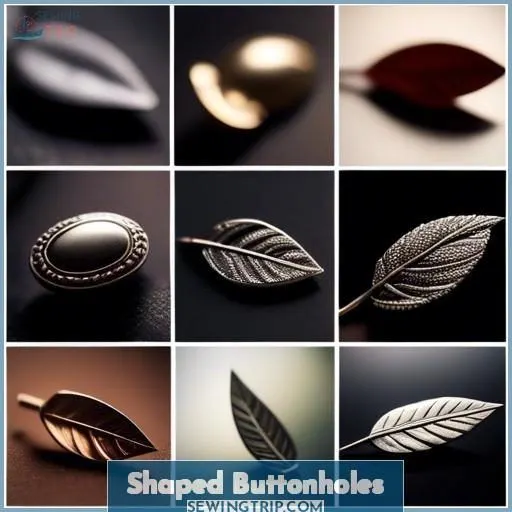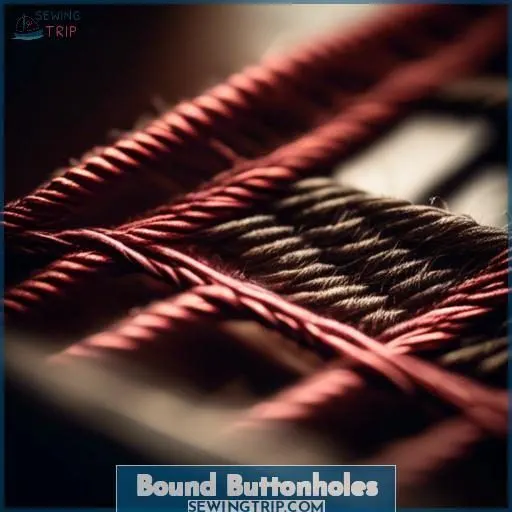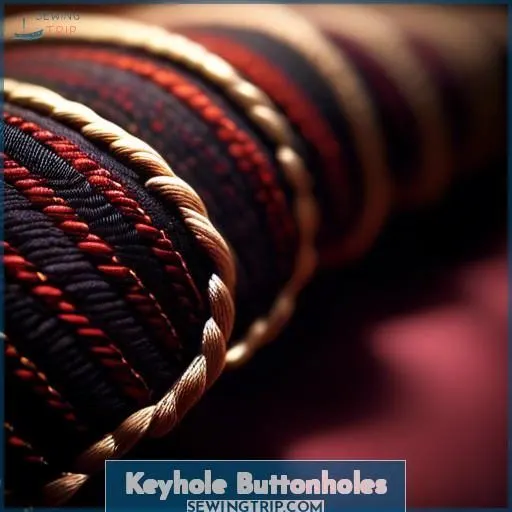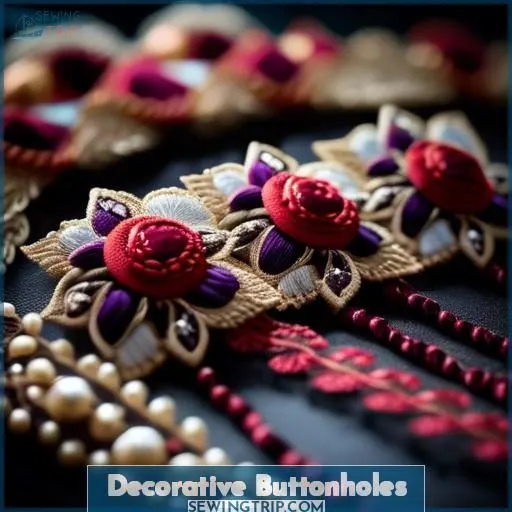This site is supported by our readers. We may earn a commission, at no cost to you, if you purchase through links.
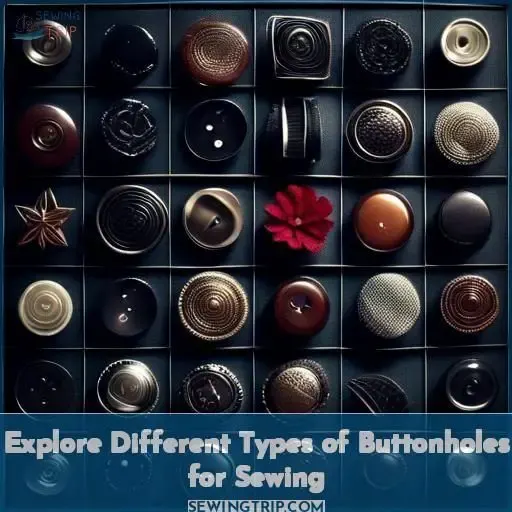
Explore the diverse world of buttonholes and elevate your sewing skills by learning about the various types available. From hand-sewn to machine-crafted, each style offers unique benefits and applications for different garments.
Hand-sewn buttonholes are created using a needle and thread, while machine-sewn buttonholes are made using a sewing machine. Faced buttonholes add a polished look to garments, and in-seam buttonholes are sewn directly into garment seams for increased durability.
Shaped buttonholes, such as triangular or hexagonal, can be hand-sewn or machine-crafted and add a unique touch to garments. Bound buttonholes, keyhole buttonholes, and decorative buttonholes each have their own distinct characteristics, making them suitable for different garment types and styles.
By understanding these different types of buttonholes, you can enhance your sewing skills and create garments that truly stand out.
Table Of Contents
- Key Takeaways
- Hand-Sewn Buttonholes
- Machine-Sewn Buttonholes
- Faced Buttonholes
- In-Seam Buttonholes
- Shaped Buttonholes
- Bound Buttonholes
- Keyhole Buttonholes
- Decorative Buttonholes
- Made by Hand Using a Needle and Thread
- Can Be Used for Various Garments
- Time-consuming Process
- Requires Precision and Skill
- Can Be Used for Decorative Purposes
- Created Using a Sewing Machine
- Suitable for Different Fabric Types and Garments
- Can Be Customized in Size and Shape
- Suitable for Sleeves or Open Lapels
- Can Create a Continuous Facing Strip for Multiple Buttonholes
- Often Used in Women’s Garments
- Created Within the Seam Allowance of a Garment
- Can Be Hand-sewn or Machine-sewn
- Requires Careful Alignment and Stitching
- Can Be Used for Various Garment Types
- Have a Specific Shape, Such as Triangle or Hexagon
- Time-consuming to Create
- Add a Unique Touch to Garments
- Can Be Made by Hand or Machine
- Resemble a Double Welt Pocket
- Often Used on Tailored Clothing
- Requires Careful Stitching and Alignment
- Add a Finished Look to Garments
- Found on Denim Garments
- Distinctive Shape
- Created for Embellishment Purposes
- Add a Personalized Touch to Garments
- Frequently Asked Questions (FAQs)
- Conclusion
Key Takeaways
- Hand-sewn buttonholes are a traditional method of creating buttonholes, while machine-sewn buttonholes are a more efficient option for functional and decorative buttonholes in garments.
- Faced buttonholes add a polished look to garments, and in-seam buttonholes are sewn directly into garment seams for increased durability.
- Shaped buttonholes, such as triangular or hexagonal, can be hand-sewn or machine-crafted and add a unique touch to garments.
- Bound buttonholes, keyhole buttonholes, and decorative buttonholes each have their own distinct characteristics, making them suitable for different garment types and styles.
Hand-Sewn Buttonholes
Hand-sewn buttonholes, also known as embroidered buttonholes, are a traditional method of creating buttonholes. They’re made around a slit cut in the fabric and use closely spaced blanket stitches. This method is easy to learn and can be used for various garments, from casual to formal wear.
To create a hand-sewn buttonhole, you’ll need a sewing needle, suitable thread, a buttonhole chisel, and a seam ripper. You can use a buttonhole stitch or a buttonhole foot on your sewing machine to guide the stitching process.
For a more decorative touch, you can use fabric tubes to create buttonholes that resemble bound buttonholes. Hand-sewn buttonholes are perfect for those who appreciate the art of sewing and enjoy the precision and skill required to create them.
Machine-Sewn Buttonholes
Machine-sewn buttonholes are a widely chosen option for making functional and decorative buttonholes in garments. These buttonholes are crafted using a sewing machine and come in various styles, including round, square, and keyhole. One of the primary benefits of machine-sewn buttonholes is the ability to automatically switch between bead and bartack, which can be convenient for sewing multiple buttonholes. However, this feature may necessitate manual measurement for custom sizes.
Buttonhole feet are available for sewing machines to aid in the creation of buttonholes. These feet can be used with different stitch types, such as blanket stitches or buttonhole stitches, and can assist in achieving the desired buttonhole width and tension. It’s crucial to select the appropriate buttonhole foot and stitch type for the fabric and garment being sewn.
Machine-made buttonholes can be created using one-step or four-step methods. One-step buttonholes are suitable for those who prefer a quick and easy process, while four-step buttonholes offer more customization options for each step. However, four-step buttonholes may require multiple attempts to achieve the desired length.
Buttonhole strength and durability can be influenced by the style choice, with some machines offering a wider selection of styles than others. Embroidery machines can create decorative and intricate buttonholes, adding a personalized touch to garments.
When creating machine-sewn buttonholes, it’s vital to maintain precise alignment and stitching to achieve a professional finish. With the proper tools and techniques, machine-sewn buttonholes can be a reliable and efficient way to add buttonholes to garments.
Faced Buttonholes
Faced buttonholes are a type of buttonhole that adds a polished and professional look to garments. They’re easy to sew and can be used for various garments, including sleeves and open lapels. Here’s a step-by-step guide on how to create faced buttonholes:
- Facing Fabric: Choose a suitable fabric for the facing, such as a lightweight interfacing. This will help to make the welts less bulky and easier to sew and cut.
- Button Spacing: Measure the width and length of the openings required in the facing. Make sure the openings are 4mm wide and 2mm longer than the actual buttonholes to guarantee they’re free and clear of the buttonhole itself.
- Thread Tension and Needle Size: Use a suitable thread tension and needle size for your fabric. This will help to guarantee a smooth and even stitch.
- Reinforcement: Interface around the area of the buttonholes if you’re interfacing the facing. This will provide additional strength and durability to the buttonholes.
- Cut and Pin: Carefully slash the buttonhole openings and turn the organza strips to the wrong side of the facing. Press and/or hand baste in place.
- Stitch the Facing: Stitch the facing to the garment front, making sure the buttonholes align perfectly with the facing.
Faced buttonholes are a great choice for those who want to add a professional and polished look to their garments. They’re suitable for various garments, including sleeves and open lapels, and can be made from the same cloth as the garment. With a little practice, you can create beautiful faced buttonholes that will enhance the overall appearance of your sewing projects.
In-Seam Buttonholes
In-seam buttonholes are a type of buttonhole placement that involves sewing the buttonhole directly into the seam of a garment. This placement provides several benefits, including increased durability and reinforcement techniques, which are particularly useful for garments that receive a lot of wear. Additionally, in-seam buttonholes can be made using a variety of fabric types and button styles, making them suitable for a wide range of garments.
When creating in-seam buttonholes, it’s important to take into account the fabric selection and button compatibility. For instance, heavier fabrics may require additional reinforcement techniques to make sure the buttonhole maintains its shape. Similarly, the choice of button can impact the overall appearance and functionality of the buttonhole.
In-seam buttonholes can be created using a sewing machine, with various buttonhole types available, such as standard, narrow, and keyhole buttonholes. These buttonhole styles can be adjusted to suit different fabrics and garments, ensuring a perfect fit and a professional finish. Additionally, some sewing machines offer specialized features like automatic buttonhole functions, which can simplify the process and help achieve consistent results.
To create in-seam buttonholes, follow these steps:
- Choose the appropriate buttonhole style for your fabric and garment.
- Mark the placement of the buttonhole on the seam, ensuring it’s correctly aligned with the garment’s design.
- Sew the buttonhole using a sewing machine, following the manufacturer’s instructions for your specific machine.
- Reinforce the buttonhole area with interfacing or stabilizers, if necessary, to prevent stretching and maintain the buttonhole’s shape.
- Test the buttonhole with the intended button to ensure proper fit and function.
In-seam buttonholes are a versatile option for sewing various garments, offering both functionality and aesthetic appeal. By understanding the different types of buttonholes and their suitability for different fabrics and garments, you can create professional-looking buttonholes that enhance the overall quality of your sewing projects.
Shaped Buttonholes
Shaped buttonholes add a special touch to unique garments, making them stand out on any special occasion. These buttonholes aren’t just functional but also serve as decorative accents. They come in various shapes, such as triangular or hexagonal, and can be made from specific fabrics to match custom designs. Creating a shaped buttonhole can be time-consuming, but the result is worth it.
You can use a sewing machine to create these buttonholes, or go the extra mile and hand-sew them for an even more personalized touch. Shaped buttonholes can be used in various garments, including keyhole buttonholes, which are often found on denim garments and have a distinctive shape.
Embroidered buttonholes are another option, perfect for adding a decorative touch to garments. With shaped buttonholes, you can truly make your garments your own.
Bound Buttonholes
Bound buttonholes are a custom detail that adds a refined look to garments, often found on high-fashion jackets and coats. They involve sewing a narrow, folded strip of fabric over the buttonhole opening, which can be a bit daunting for beginners due to the precision needed. However, with the right technique and practice, bound buttonholes can be sewn effortlessly and accurately. Here are four steps to assist you in creating bound buttonholes:
- Measure and mark the buttonhole placement: Use a ruler or measuring tape to determine the desired buttonhole location, considering the size of the button and the width of the welt. Mark the buttonhole box on the fabric and interfacing.
- Cut and pin the patch: Cut a patch of fabric about 4 inches by 4 inches on the bias, then pin it over the basted box, right sides together.
- Stitch around the box: From the wrong side of the fabric, stitch around the box, starting from a long side. Be sure to count the stitches to guarantee they’re the same length on both ends.
- Cut the buttonhole box and pass the patch: Carefully cut through both layers of the fabric and patch from the center, then pass the patch through the open box and lay it flat. Press lightly to maintain the shape, but ensure the edges don’t show from the right side.
To make the bound buttonhole look neat and symmetrical, fold the top and bottom of the patch to form the first and second lips of the buttonhole, then pin and press in place. Finally, stitch the triangles at the ends of the buttonhole box to secure the folds.
Keyhole Buttonholes
Keyhole buttonholes are a type of buttonhole that adds a distinctive appearance to denim garments. They’re round-end buttonholes that can be used for decorative purposes and embellishment ideas. Unlike other buttonhole styles, keyhole buttonholes are horizontal, which makes them unique and eye-catching. These buttonholes are suitable for denim garments and can be used to create a personalized touch to your sewing projects.
To create a keyhole buttonhole, you can use a sewing machine with a keyhole buttonhole foot. This foot has a round, tapered end that creates the distinctive shape of the buttonhole. You can also create keyhole buttonholes by hand, using a needle and thread. This method requires precision and skill, but it allows you to customize the size and shape of the buttonhole to your liking.
When sewing keyhole buttonholes, it’s crucial to make sure that the stitching is accurate and the alignment is correct. This will help to ensure that the button fits securely and the buttonhole looks neat and professional. You can also use a keyhole buttonhole chisel to help guide your stitching and create a perfectly shaped buttonhole.
Decorative Buttonholes
Explore the realm of decorative buttonholes, where meticulousness and artistry converge to craft distinctive adornments for diverse garments. From meticulously hand-stitched buttonholes to their machine-crafted counterparts, a vast array of designs and methodologies await your selection, each imbuing your sewing endeavors with an individualized flair.
Made by Hand Using a Needle and Thread
Explore the art of hand-sewn buttonholes, a decorative and personalized touch to your garments. Using a needle and thread, you can create beautiful buttonholes using techniques such as blanket stitch or buttonhole stitch. These stitches, while similar in appearance, have distinct differences. Blanket stitch is a simple embroidery stitch often used for edging, while buttonhole stitch has an extra loop along the edge for added strength and durability.
To create a hand-sewn buttonhole, follow these steps:
- Choose your fabric: Select a suitable fabric for your buttonhole. Consider the weight and texture of the fabric, as well as the desired appearance.
- Mark the buttonhole location: Using a ruler or measuring tape, mark the location for your buttonhole on the fabric. Make sure to measure the correct size for your button.
- Prepare the fabric: Cut a slit in the fabric along the marked line, being careful not to cut the stitches or working thread.
- Begin the buttonhole stitch: Bring the needle up through the fabric just outside the running stitch, then bring it back up through the opening. Pass the working thread behind the tip of the needle and pull the needle through. Repeat this process for each buttonhole stitch, making sure to keep the stitches even and close together.
- Finish the buttonhole: Once you have completed the buttonhole stitch, you can choose to stitch the ends straight across with satin stitch or continue with buttonhole stitch for a smoother finish.
Hand-sewn buttonholes are a time-consuming process, but the result is a beautifully crafted, personalized touch to your garments. With practice, you can master this technique and create buttonholes that add character and charm to your sewing projects.
Can Be Used for Various Garments
Decorative buttonholes are a versatile choice for sewing enthusiasts. They can be used to embellish various garments, from casual wear to formal attire. With a range of styles and customization options, these buttonholes add a unique touch of creativity to your sewing projects. Choose from hand-sewn or machine-sewn options, button loops, or even shaped buttonholes for added durability and strength.
Time-consuming Process
Crafting decorative buttonholes, like the intricate piped or corded varieties, isn’t a sprint; it’s a marathon. Embroidery and embellishment transform them into more than mere functional features—they become a statement. Choosing the right fabric is essential, as is deciding between box, stretch, or invisible styles.
Requires Precision and Skill
Hand-stitched buttonholes demand accuracy and expertise, guaranteeing the longevity of your garments. With hand-stitched buttonholes, you can craft ornamental embellishments and detailed designs, ideal for various garments.
The fabric’s thickness and the shape of the buttonhole stand are pivotal elements to bear in mind when stitching. Easy-to-make one-step buttonholes and specialty buttonholes can be made with ease, while vertical buttonholes and rounded buttonholes necessitate greater attention to detail.
Can Be Used for Decorative Purposes
Discover the decorative potential of buttonholes! From embroidered designs to frog closures and rouleau buttonhole loops, these embellishment options offer customization possibilities for various fabric suitabilities. Hand-sewn buttonholes with closely spaced blanket stitches can add a unique style to your garments. Buttonhole alternatives like shaped buttonholes can create a personalized touch, adding a decorative flair to your sewing projects.
Created Using a Sewing Machine
Creating buttonholes with a sewing machine is a popular and efficient method for various types of garments. This technique involves using a buttonhole foot, which is a specialized attachment for sewing machines, to create buttonholes. The process is straightforward and can be done using a one-step stitch or a four-step stitch, depending on the sewing machine model and the desired buttonhole style.
One-step buttonholes are convenient and allow for quick and easy buttonhole creation. They’re suitable for a variety of fabrics and garments, including shirts, pants, and jackets. These buttonholes are typically made with a zigzag stitch, which provides a decorative and functional opening for buttons. One-step buttonholes are often preferred for their simplicity and speed, as they require minimal setup and adjustment on the sewing machine.
Four-step buttonholes, on the other hand, offer more customization options. They require the user to manually select the bead and bartack patterns, stitched out in four separate steps. This process allows for more precise control over the buttonhole’s appearance and can result in a more polished and professional-looking finish. Four-step buttonholes are suitable for a wider range of buttonhole sizes and can be used for more intricate designs, such as shaped buttonholes with specific shapes like triangles or hexagons.
Suitable for Different Fabric Types and Garments
Decorative buttonholes are appropriate for various fabric types and garments. They can be used to enhance fabric strength and act as decorative embellishments. Buttonhole placement and size are significant factors to consider when selecting the right buttonhole for your garment. Here are some aspects to bear in mind:
- Fabric strength: Examine the fabric’s strength and durability when choosing a buttonhole style. Some styles may be more suitable for heavier fabrics, while others may be better for lighter materials.
- Decorative embellishments: Decorative buttonholes can add a unique touch to garments, making them more visually appealing and personalized.
- Garment embellishments: Buttonholes can be used to create intricate designs and patterns on garments, enhancing their overall appearance.
- Buttonhole placement: The placement of buttonholes is essential for the functionality and aesthetic of the garment. Consider the garment’s design and intended use when deciding where to place the buttonholes.
- Buttonhole size: The size of the buttonhole should match the size of the button it will be used with. This ensures a proper fit and prevents damage to the fabric.
Can Be Customized in Size and Shape
Customizing buttonhole size and shape allows for personalization and fabric compatibility. Choose thread and bartack patterns for reinforcement. Consider placement and stitch type for a polished look.
Suitable for Sleeves or Open Lapels
To create a faced buttonhole suitable for sleeves or open lapels, you need to consider the placement, length, and tension of the bar tack. The bar tack length should be the same as the button’s diameter, and the thread tension should be consistent to ensure a neat appearance.
When sewing the facing strip, the seam allowance may need to be adjusted to fit the placement of the buttonhole. Top stitching may also be required to keep the facing in place.
Can Create a Continuous Facing Strip for Multiple Buttonholes
Creating a continuous facing strip for multiple buttonholes is a feature often seen in women’s garments. This technique involves sewing a strip of fabric along the edge of the garment, which can then be used to create buttonholes at regular intervals.
The facing strip can be made from the same fabric as the garment, and the buttonholes can be spaced evenly along the strip to guarantee a neat and consistent appearance. This method is particularly useful for garments with multiple buttonholes, as it eliminates the need to sew each buttonhole individually.
The facing strip can also be used to create a decorative effect, as the buttonholes can be placed in a pattern or design of your choice.
Often Used in Women’s Garments
Decorative buttonholes frequently grace women’s garments, infusing them with an air of refinement and sophistication. These buttonholes adorn diverse areas of the garment, such as the lapel, sleeve, or open lapel. They can be crafted using a continuous facing strip, which enables multiple buttonholes to be stitched in a line. This feature is particularly advantageous for jackets and coats, where a row of buttonholes is necessary to secure the garment.
Faced buttonholes are a prevalent choice for women’s garments, as they’re straightforward to sew and can be fabricated from the same material as the garment. They can be employed for sleeve buttonholes, open lapel buttonholes, or even for creating a continuous facing strip for multiple buttonholes. This type of buttonhole is appropriate for various garments, including dresses, blouses, and jackets.
In addition to their functional role in securing garments, decorative buttonholes can also serve as an aesthetic element. They can be shaped, such as triangles or hexagons, adding a distinctive touch to the garment. These shaped buttonholes can be employed to create a personalized and captivating look, making the garment stand out.
When selecting decorative buttonholes for women’s garments, it’s crucial to examine the style of the garment and the fabric utilized. Diverse styles of buttonholes may be more suitable for different fabrics and garments. For instance, bound buttonholes, which resemble a double welt pocket, are often employed on custom-made clothing, while keyhole buttonholes are found on denim garments.
Created Within the Seam Allowance of a Garment
Creating buttonholes within the seam allowance of a garment allows for a decorative touch. The choice of fabric thickness, button size, and garment style influences thread choice and reinforcement techniques. Hand-sewn or machine-sewn buttonholes can be used, with the former offering a more personalized touch.
Can Be Hand-sewn or Machine-sewn
In the realm of decorative buttonholes, you’re presented with the choice between hand-sewn or machine-sewn techniques. Hand-sewn embellishments permit intricate patterns and a personal flair, while machine-sewn buttonholes provide resilience and adaptability.
Fabric loop buttonholes can be crafted by hand or machine, offering flexibility in your sewing endeavors. Shaped buttonholes lend a creative embellishment to your garments, and keyhole buttonholes offer a distinctive appearance for denim garments.
Requires Careful Alignment and Stitching
Creating buttonholes requires meticulous alignment and stitching to guarantee accuracy and precision. This is especially crucial when making decorative buttonholes, which can add a distinctive touch to garments. Here are some tips to help you achieve optimal results:
- Alignment: Confirm that the buttonhole markings are precise and aligned with the button placement. This can be done by indicating the buttonhole positions on the fabric before stitching, using a marking tool like a vanishing ink pen or chalk.
- Precision: Aim for accuracy in your stitching, as this will help prevent uneven buttonholes. Use a needle with a sharp point and a thread that corresponds with the fabric. If you’re using a sewing machine, verify that the needle is properly aligned and the tension is correct.
- Patience: Decorative buttonholes can be time-consuming, so be patient and take your time. Practice your stitching on scraps of fabric before starting on your project to get a sense of the technique.
- Strength: Use a robust thread and make sure the stitches are tight to prevent fraying and ensure the buttonhole can support the weight of the button. For hand-sewn buttonholes, consider using a four-cord or gimp to provide extra strength and stability.
- Alignment tools: Use tools like seam rippers or buttonhole chisels to help align the fabric and guarantee the buttonhole is properly centered.
Can Be Used for Various Garment Types
As you align and stitch with precision, remember that buttonholes aren’t just functional; they’re fashion chameleons. Whether you’re working with silk or denim, the right thread selection and placement considerations can transform a simple cut into a statement. Reinforcement techniques guarantee longevity, while decorative embellishments add flair.
Have a Specific Shape, Such as Triangle or Hexagon
Shaped buttonholes add a touch of elegance to your garments. With their intricate details, they can serve as decorative accents, making your clothing stand out. These buttonholes can be customized to have a specific shape, such as triangle or hexagon, adding a unique touch to your garments. Here are four ways to create shaped buttonholes:
- Embroidery: Use an embroidery machine to create intricate designs on your buttonholes.
- Hand Sewing: Sew each stitch individually to create a custom shape.
- Machine Sewing: Use a buttonholer attachment on your sewing machine to create shaped buttonholes.
- Patterns: Use pre-made patterns to guide your sewing and create a consistent shape.
Time-consuming to Create
Creating decorative buttonholes can be a time-intensive process, especially when using heavy fabrics or intricate designs. Embroidered buttonholes, for example, require careful hooping and stabilization to guarantee precise stitching. However, the outcome is a beautiful, customized embellishment that adds a touch of elegance to your garments, making them suitable for special occasions.
Add a Unique Touch to Garments
Add a unique touch to your garments with decorative buttonholes. Choose from buttonhole embellishment options like shaped buttonholes, fabric loop buttonholes, and intricate machine stitches. Hand-crafted elegance is just a few stitches away.
Can Be Made by Hand or Machine
After adding that unique touch, explore the realm of decorative buttonholes. Whether by hand or machine, consider buttonhole placement, stitch density, thread selection, and fabric thickness. These elements are critical in crafting those captivating embellishments that elevate a garment to distinction.
Resemble a Double Welt Pocket
Bound buttonholes are a popular choice for adding a clean, professional finish to garments. They’re often used in coats, jackets, and fitted garments. To create a bound buttonhole, you’ll need to follow these steps:
- Fabric Selection: Choose a fabric that’s suitable for sewing bound buttonholes. This could be the same fabric as your garment or a contrasting fabric for added visual impact.
- Buttonhole Placement: Place your button below the stitch line along the top edge of your fabric. This top edge is usually the corner of the garment.
- Buttonhole Tools: You’ll need a sewing machine, hand sewing needle, suitable thread, seam ripper, and possibly a buttonhole chisel.
- Buttonhole Finishing: After sewing the buttonhole, you may need to finish it by trimming the fabric and stitching the facing buttonhole to the outer buttonhole. This step can be done by hand.
- Buttonhole Reinforcement: If you’re working with a lightweight garment, consider adding interfacing to the buttonhole patch to provide extra structure.
Often Used on Tailored Clothing
Hand-sewn buttonholes, also known as custom buttonholes, are a common feature in custom garments. They’re often used on custom clothing to add a level of sophistication and detail. These buttonholes are created by hand using a needle and thread, typically in a buttonhole stitch or blanket stitch. They’re often found in the seam allowance of a garment and can be customized in size and shape to suit the specific garment.
Custom buttonholes are often used on garments that require a high level of precision and skill, such as coats and suits. They can be made on various fabric types, including heavy fabrics, and require careful hooping and stabilization to guarantee they’re strong and durable. These buttonholes can be time-consuming to create, but the end result is a beautiful, decorative feature that adds to the overall look of the garment.
To create a custom buttonhole, you’ll need a sewing machine, hand sewing needle, suitable thread, seam ripper, buttonhole chisel, and possibly a buttonhole gauge to guarantee accurate spacing. The process involves marking the position of the buttonhole, outlining the hole with a running stitch, and then filling in the hole with a series of stitches to create the buttonhole. It’s important to use a sharp needle and high-quality thread to guarantee the buttonhole is strong and durable.
Custom buttonholes are often used on garments that require a high level of precision and skill, such as coats and suits. They can be made on various fabric types, including heavy fabrics, and require careful hooping and stabilization to guarantee they’re strong and durable. These buttonholes can be time-consuming to create, but the end result is a beautiful, decorative feature that adds to the overall look of the garment.
Requires Careful Stitching and Alignment
When crafting decorative buttonholes, precision is your best friend. Nail the alignment and accuracy with practiced techniques, ensuring placement is spot-on. It’s like threading a needle—fiddly, but oh-so satisfying when you hit the mark.
Add a Finished Look to Garments
Decorative buttonholes can add a finished look to your garments. These buttonholes enhance the strength and durability of your garment while also providing an embellishment value. You can choose from various buttonhole fabrics and styles to complement your garment’s style. Whether you’re sewing by hand or using a machine, decorative buttonholes are a perfect way to add a personalized touch to your creations.
Found on Denim Garments
Denim garments frequently feature keyhole-style buttonholes, which not merely add a distinctive touch but also bolster the denim’s resilience. Keyhole positioning is paramount for proper buttonhole function and aesthetic appeal. These buttonholes can be crafted by hand or machine, offering versatility for sewers.
Distinctive Shape
Delve into the realm of ornate buttonholes, where strategic keyhole placement, adornments, and reinforcements imbue garments with a distinctive flair. Amidst a myriad of silhouettes and aesthetics, keyhole buttonholes can be tailored to your discerning tastes. Here are four pivotal factors to ponder:
- Keyhole positioning: Artfully position buttonholes for a harmonious balance.
- Embellishment: Enhance the keyhole form with decorative flourishes.
- Reinforcement: Fortify the buttonhole with robust stitching or interlining.
- Keyhole outline and style: Select from a spectrum of shapes and styles to complement your garment’s allure.
Created for Embellishment Purposes
Explore the realm of decorative buttonholes, crafted to enhance your creations. These buttonholes bestow visual allure and serve as expressions of your style. Tailor-made designs can be crafted using diverse stitch patterns and forms, such as triangles or hexagons. Integrate these distinctive elements into your sewing endeavors for a touch of individuality.
Add a Personalized Touch to Garments
Adding personalized touches to garments is a great way to make them distinctive. Decorative buttonholes, also known as embellished buttonholes, can be created using various needlework techniques such as hand embroidery and satin stitch. These buttonholes not only enhance their elegance but also demand precision and expertise.
Whether you prefer to create them by hand or with a sewing machine, the outcome is a unique garment that truly mirrors your style.
Frequently Asked Questions (FAQs)
What is the recommended placement for buttonholes on a garment?
To guarantee a seamless fit and avoid gaping, position a button between the bust points on the garment. Subsequently, wear the garment and observe where the front naturally opens above the bust point. Position a button there, adjusting the buttonhole placement accordingly, taking into consideration the garment’s closeness and the size of the button.
How do I determine the correct size of the buttonhole for a specific button?
To determine the correct buttonhole size, simply add 1/8 inch (3 mm) to the button diameter. For example, a 1/2 inch (25 cm) button needs a 5/8 inch (6 cm) buttonhole.
What is the difference between a standard buttonhole and a keyhole buttonhole?
A standard buttonhole and a keyhole buttonhole differ in their shape and intended use. A standard buttonhole is a rectangular or oval-shaped hole with parallel rows of stitches on either side, used for medium to heavyweight fabrics. It’s the most common type of buttonhole found on garments and home décor.
On the other hand, a keyhole buttonhole has a distinctive keyhole shape, with one end of the hole featuring a small circle of stitches. This type of buttonhole is suitable for heavy fabrics and thick buttons or buttons with shanks, often found on jackets, coats, and jeans. It allows the button to move through the thick layers of fabric more easily.
Can I use a different type of thread for sewing buttonholes?
Yes, you can use a different type of thread for sewing buttonholes. The choice of thread depends on the type of fabric and the desired appearance. For woven fabrics, a good-quality 100 percent cotton thread is recommended, as it’s slightly fluffier and fills in the buttonhole stitches for better coverage.
For knits and wovens with spandex, polyester thread is suitable due to its slight stretch that allows buttonholes to give as the fabrics move. Additionally, silk or waxed silamide threads can be used for extra-fine or high-end garments.
It’s essential to choose a thread that’s both decorative and extra strong to hold buttons securely and prevent fraying.
How do I prevent my buttonholes from stretching or fraying?
To prevent your buttonholes from stretching or fraying, you can use interfacing, which stabilizes the fabric during stitching and prevents it from stretching out during wear. You can also use tear-away stabilizers, which can be found where machine embroidery supplies are sold, and are available in fabric stores.
Additionally, applying Fray Check, a liquid seam sealant, can help prevent the cut fabric from fraying and keep threads tidy.
Conclusion
Ironically, mastering the art of creating various types of buttonholes might seem like a small detail in the grand scheme of sewing. Yet, it’s these nuances that elevate your garments from ordinary to extraordinary.
Whether you’re hand-stitching a decorative buttonhole, machining a durable keyhole, or crafting a unique shaped closure, each type serves its purpose. By honing your skills in these techniques, you’ll add a personalized and polished touch to your creations, making them truly stand out.

